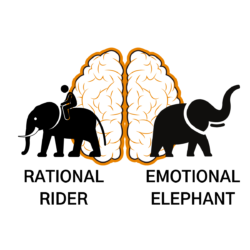SERIES: Thought Leadership Derived From Switch: How to Change Things When Change is Hard – Part 2

Have you ever tried to launch a new initiative at work and after weeks of presentations, training, and implementation, you realize there is a lack of enthusiasm and an overabundance of stagnation in adopting the new program? You’ve explained the rationale behind it, you’ve promised them that revenues will increase by 20% in the next year, and you’ve even told them how easy it is to work within this new program. Why can’t you rally people?
It seems that you appealed to the “head” rather than the “heart.”
In the book, Switch: How to Change Things When Change is Hard, authors Dan and Chip Heath use two characters, the Rider and the Elephant, to explore the dichotomy of rational and emotional decision-making, i.e. head vs. heart. The authors present three key actions you can take – Direct the Rider, Motivate the Elephant, and Shape the Path, to help leaders and lay-people find an easier way to influence change.
In the first article of this three-part series, we learned about the rational side of decision-making using the illustrative example of the Rider. The Rider appreciates a strategic route with a clear destination and logical justification for change. But rationalization alone will not sustain changed behavior. To make changes in your organization and effectively shift human behavior, you must also engage the emotional side of people.
Here, I introduce our lovable, large, and overbearing friend, the emotional Elephant. While the Rider is representative of the rational parts of our brain, the Elephant represents the emotional side. Emotion is what we use to motivate ourselves into action. The Rider, with all his strategy and logic, can try to force the Elephant in a particular direction, but without proper motivation, the Elephant will either go its own way or refuse to move at all.
So, how do you motivate a two-ton emotional force? Switch authors recommend these three tools: find the feeling, shrink the change, and grow your people. We’ll explore each of these in reference to organizational change.
TAKE THESE 3 ACTIONS TO MOTIVATE PEOPLE
1. Find the feeling
If you want your sales team to reach new potential customers, you could just tell them to do so – which may get some reaction, but not necessarily an enthusiastic one. To make this change really stick, you want your team to be innovative and proactive in finding new customers. But have you given them any reason to care as much as you do? In addition to the clear instruction and clear goal, try also to find the feeling. Consider framing the new directive in a way that suggests relationship building. Help your team appreciate the purpose and benefit behind your product. Explain that their goal is to create relationships based on helping customers. This takes the bottom line out of the discussion and inserts an empathetic reason for the sales team to reach out to new potential customers. They will feel motivated to help the greater good of the customer, and their efforts will be associated with an accomplishment.
2. Shrink the change
In addition to “feeling” the change, your team will need to know that the new initiative is feasible. Therefore, as a leader you must find a way to make the change smaller. When you have an impending change in your organization and the end goal is big and lofty, it is hard for the emotional Elephants to get motivated. But when you can break the change effort into smaller pieces, it makes the change seem less daunting. This is what the authors of Switch call shrinking the change.
 To shrink the change, give the team an easily attainable first step – something that can be done in a day or a week. For example, in the first week, instruct your sales team to identify one new potential customer. That’s it. That is their goal. They don’t have to set up a meeting, all they have to do is identify a potential new customer. However, once they do that, you may have ignited the fire to keep going and there is a good chance they then set up a meeting. Following that meeting, they will feel accomplished. The next week, they might set the same goal: identify one more potential customer. Again, this will likely lead to a meeting. Small wins can be an incredible motivator for more progress.
To shrink the change, give the team an easily attainable first step – something that can be done in a day or a week. For example, in the first week, instruct your sales team to identify one new potential customer. That’s it. That is their goal. They don’t have to set up a meeting, all they have to do is identify a potential new customer. However, once they do that, you may have ignited the fire to keep going and there is a good chance they then set up a meeting. Following that meeting, they will feel accomplished. The next week, they might set the same goal: identify one more potential customer. Again, this will likely lead to a meeting. Small wins can be an incredible motivator for more progress.
3. Grow Your People
The third approach in motivating the often unmovable, emotional Elephant is to grow your people, or create a collective identity around the end goal. For example, if you have a sales team that needs to be more proactive on reaching new customers, you must first communicate what they will need to do, i.e. Direct the Rider, and then begin to paint a picture of who they will be – a sales team that others in the company look up to because they are steering the ship in the right direction. Creating this aspirational persona often motivates people to work through even the most challenging parts of the change – all because they want to become the dependable, well-respected sales team. Accepting the setbacks and celebrating the small wins are characteristics of a concept called “growth mindset.” Advocating for a growth mindset is a strong way to encourage your team to identify with small wins as well as failure, associating both as part of the learning process on the way to success.
As a leader, implementing and promoting change can be challenging. Understanding and accommodating the struggle between rational and emotional decision-making helps make that change a little easier. In part one and two of this series, we’ve learned the characteristics of our Rider and Elephant and how they can work together. But to really drive your change to the finish line, you have to create a conducive environment for the change to happen. In the third and final part of this series, we’ll learn how to Shape the Path to change.
If your organization confronts a change management situation, Fahrenheit Advisors stands ready with experienced consulting resources who can help identify challenges, overcome them and implement a process that appeals to both hearts and minds of those most affected. Contact us at experts@fahrenheitadvisors.com.
About the Author
 Megan Price provides a broad range of experience in strategy development, project management, organizational behavior, corporate culture, stakeholder relations, process integration, and change management. She encourages a collaborative process and tailors work to her individual client.
Megan Price provides a broad range of experience in strategy development, project management, organizational behavior, corporate culture, stakeholder relations, process integration, and change management. She encourages a collaborative process and tailors work to her individual client.
